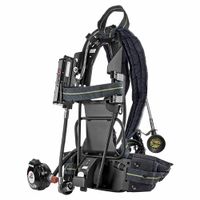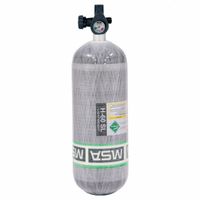Call +(254) 703 030 000 / 751 483 999 / 721 704 777
- Home
- Safety
- Respiratory Protection
- Scba Self Contained Breathing Apparatus Systems Components
.....Read More
Frequently Asked Questions
What is an SCBA and how does it work?
A Self-Contained Breathing Apparatus (SCBA) is a device worn by individuals to provide breathable air in environments that are immediately dangerous to life or health (IDLH), such as in firefighting, hazardous material handling, or confined space entry. It is essential for situations where the ambient atmosphere is oxygen-deficient or contains toxic gases.
An SCBA consists of three main components: a high-pressure air cylinder, a pressure regulator, and a face mask or full-facepiece respirator. The air cylinder, typically made of aluminum, steel, or composite materials, stores compressed air at pressures ranging from 2,216 to 4,500 psi. The pressure regulator reduces the high-pressure air to a breathable level, ensuring a steady flow of air to the user. The face mask, equipped with a demand valve, seals tightly against the face to prevent contaminated air from entering and allows the user to inhale air on demand.
The SCBA operates on a closed-circuit or open-circuit system. In an open-circuit SCBA, exhaled air is released into the environment, while in a closed-circuit SCBA, exhaled air is recycled, scrubbed of carbon dioxide, and supplemented with oxygen, making it suitable for longer durations.
SCBAs are designed to be lightweight and ergonomic, allowing for mobility and ease of use in challenging conditions. They often include features like an integrated PASS (Personal Alert Safety System) device, which emits an alarm if the wearer becomes motionless, enhancing safety.
Overall, SCBAs are critical for protecting individuals from respiratory hazards, enabling them to perform tasks safely in environments where breathing unassisted would be impossible or dangerous.
How long does an SCBA tank last?
The duration an SCBA (Self-Contained Breathing Apparatus) tank lasts depends on several factors, including the tank's capacity, the user's breathing rate, and the work environment.
1. **Tank Capacity**: SCBA tanks typically come in different sizes, commonly 30, 45, or 60 minutes, which indicates the duration they are designed to last under standard conditions. This is based on a nominal breathing rate of 40 liters per minute.
2. **Breathing Rate**: The actual duration can vary significantly based on the user's physical activity and stress level. A person at rest will consume air more slowly than someone engaged in strenuous activity. For instance, during heavy exertion, the breathing rate can increase to 100 liters per minute or more, reducing the tank's duration.
3. **Environmental Conditions**: Factors such as temperature, altitude, and the presence of contaminants can also affect how long the air supply lasts. Higher altitudes and extreme temperatures can increase the rate of air consumption.
4. **Safety Margin**: SCBA tanks are often used with a safety margin in mind. Users are trained to monitor their air supply and return to a safe environment before the tank is depleted. Alarms typically sound when the air supply is low, usually at about 25% remaining.
In practice, a 30-minute SCBA tank might last only 15-20 minutes during intense physical activity, while a 60-minute tank might last 30-45 minutes under similar conditions. Proper training and regular practice are essential for users to understand how long their SCBA will last in different scenarios.
What are the main components of an SCBA system?
The main components of a Self-Contained Breathing Apparatus (SCBA) system include:
1. **Cylinder**: This is a high-pressure tank that stores compressed air. It is typically made from aluminum, steel, or composite materials to ensure durability and lightweight handling. The cylinder is equipped with a valve to control the release of air.
2. **Regulator**: The regulator reduces the high pressure of the air from the cylinder to a breathable level. It ensures a consistent flow of air to the user, regardless of the pressure in the cylinder.
3. **Facepiece (Mask)**: The facepiece is a full-face mask that provides a seal around the user's face to prevent contaminated air from entering. It is equipped with a clear visor for visibility and a voice communication system for communication.
4. **Harness and Backplate**: The harness is a system of straps and buckles that secure the SCBA to the user's body. The backplate provides support and distributes the weight of the cylinder evenly across the back, allowing for comfortable wear during extended use.
5. **Pressure Gauge and Alarm**: The pressure gauge displays the remaining air pressure in the cylinder, allowing the user to monitor air supply. An integrated alarm system alerts the user when the air supply is low, typically at 25% of the total capacity.
6. **Demand Valve**: Also known as the second-stage regulator, the demand valve delivers air to the facepiece only when the user inhales, conserving air supply.
7. **PASS Device (Personal Alert Safety System)**: This is an electronic device that emits a loud alarm if the user remains motionless for a certain period, indicating a potential emergency situation.
These components work together to provide a safe and reliable supply of breathable air in hazardous environments.
How do you properly maintain and inspect an SCBA?
To properly maintain and inspect a Self-Contained Breathing Apparatus (SCBA), follow these steps:
1. **Daily Inspection:**
- **Visual Check:** Inspect the harness, straps, and buckles for wear or damage. Ensure the facepiece is clean and free of cracks or tears.
- **Cylinder Check:** Verify the cylinder is fully charged (usually 90-100% of capacity) and check for any physical damage.
- **Regulator and Hoses:** Inspect for cracks, leaks, or signs of wear. Ensure connections are secure.
- **Alarm Systems:** Test the low-pressure alarm and any integrated PASS (Personal Alert Safety System) devices.
2. **Weekly Inspection:**
- **Functional Test:** Conduct a full operational check. Don the SCBA and ensure the regulator delivers air properly. Check the bypass valve and ensure it functions correctly.
- **Facepiece Seal:** Perform a negative and positive pressure test to ensure a proper seal.
- **Battery Check:** If applicable, check and replace batteries in electronic components.
3. **Monthly Maintenance:**
- **Cleaning:** Clean the facepiece and other components with mild soap and water. Disinfect using approved solutions.
- **Lubrication:** Apply manufacturer-recommended lubricants to moving parts if necessary.
- **Record Keeping:** Document inspections, maintenance, and any repairs in a logbook.
4. **Annual Inspection:**
- **Professional Servicing:** Have the SCBA serviced by a certified technician. This includes a thorough inspection, testing, and any necessary repairs or part replacements.
- **Hydrostatic Testing:** Ensure cylinders undergo hydrostatic testing as per manufacturer and regulatory guidelines, typically every 3-5 years.
5. **Storage:**
- Store SCBA in a clean, dry area away from direct sunlight and contaminants. Ensure it is easily accessible in case of emergency.
Regular training and adherence to manufacturer guidelines are crucial for effective SCBA maintenance and inspection.
What are the differences between SCBA and other types of respirators?
Self-Contained Breathing Apparatus (SCBA) and other types of respirators differ primarily in their design, functionality, and applications:
1. **Air Supply**:
- **SCBA**: Provides a portable air supply, typically from a high-pressure tank, allowing the user to breathe independently of the surrounding environment. It is ideal for environments with insufficient oxygen or high levels of toxic gases.
- **Other Respirators**: Generally rely on filtering the ambient air. Types include:
- **Air-Purifying Respirators (APRs)**: Use filters or cartridges to remove specific contaminants from the air.
- **Powered Air-Purifying Respirators (PAPRs)**: Use a battery-powered blower to pass air through filters.
2. **Usage Environment**:
- **SCBA**: Suitable for immediately dangerous to life or health (IDLH) environments, such as firefighting, confined space entry, and hazardous material handling.
- **Other Respirators**: Used in environments where the air is breathable but may contain particulates, vapors, or gases that need filtering.
3. **Duration of Use**:
- **SCBA**: Limited by the air supply in the tank, typically 30 to 60 minutes.
- **Other Respirators**: Can be used as long as the filters are effective and the environment remains non-IDLH.
4. **Mobility and Weight**:
- **SCBA**: Heavier and bulkier due to the air tank, which may restrict movement.
- **Other Respirators**: Generally lighter and more comfortable for extended use.
5. **Maintenance and Training**:
- **SCBA**: Requires regular maintenance and user training to ensure safety and functionality.
- **Other Respirators**: Easier to maintain, with simpler training requirements.
6. **Cost**:
- **SCBA**: More expensive due to the complexity and need for high-pressure air tanks.
- **Other Respirators**: Generally more cost-effective, especially for long-term use in non-IDLH environments.
How do you choose the right SCBA for specific applications?
To choose the right Self-Contained Breathing Apparatus (SCBA) for specific applications, consider the following factors:
1. **Application Environment**: Determine the type of environment where the SCBA will be used. For example, firefighting requires SCBAs that can withstand high temperatures, while chemical plants may need SCBAs resistant to specific chemicals.
2. **Duration of Use**: Assess the duration for which the SCBA will be needed. SCBAs come with different air supply durations, typically 30, 45, or 60 minutes. Choose based on the expected time needed to complete tasks safely.
3. **Weight and Comfort**: Consider the weight and ergonomic design of the SCBA. Users should be able to wear it comfortably for extended periods without fatigue, especially in physically demanding situations.
4. **Certification and Standards**: Ensure the SCBA meets relevant safety standards and certifications, such as those from the National Institute for Occupational Safety and Health (NIOSH) or the European EN standards.
5. **Facepiece Fit and Visibility**: A proper fit is crucial for safety and effectiveness. Ensure the facepiece provides a good seal and offers clear visibility. Some models offer different sizes or adjustable features.
6. **Communication Systems**: In environments where communication is critical, select SCBAs with integrated communication systems to facilitate clear interaction among team members.
7. **Maintenance and Training**: Consider the ease of maintenance and availability of training for users. SCBAs should be easy to clean, inspect, and repair, with training programs available for proper use and emergency procedures.
8. **Budget and Cost**: Balance the cost with the features and durability required for the specific application. While cost is a factor, prioritize safety and compliance with regulations.
By evaluating these factors, you can select an SCBA that ensures safety, efficiency, and compliance with the specific needs of your application.
What are the safety standards and regulations for using SCBA systems?
Safety standards and regulations for using Self-Contained Breathing Apparatus (SCBA) systems are primarily governed by organizations such as the Occupational Safety and Health Administration (OSHA), the National Institute for Occupational Safety and Health (NIOSH), and the National Fire Protection Association (NFPA).
1. **OSHA Regulations**: OSHA mandates the use of SCBA systems under the Respiratory Protection Standard (29 CFR 1910.134). This includes requirements for proper selection, use, and maintenance of SCBA systems. Employers must provide training, fit testing, and medical evaluations to ensure the safety and health of workers using SCBA.
2. **NIOSH Certification**: SCBA systems must be NIOSH-certified, ensuring they meet specific performance criteria. NIOSH tests and certifies SCBA systems for factors like air quality, pressure, and duration of air supply.
3. **NFPA Standards**: NFPA 1981 specifies the design, performance, testing, and certification requirements for SCBA used by emergency services. It covers aspects such as facepiece fit, breathing resistance, and communication capabilities. NFPA 1852 provides guidelines for the selection, care, and maintenance of SCBA systems.
4. **Training and Fit Testing**: Users must undergo comprehensive training on SCBA operation, including donning and doffing procedures, emergency use, and maintenance. Fit testing ensures the facepiece forms a proper seal, critical for effective protection.
5. **Inspection and Maintenance**: Regular inspection and maintenance are crucial. SCBA systems should be checked before each use and undergo periodic detailed inspections. Components like facepieces, hoses, and regulators must be maintained according to manufacturer guidelines.
6. **Emergency Procedures**: Users must be trained in emergency procedures, including how to handle equipment failure and safely exit hazardous environments.
These standards and regulations ensure SCBA systems provide reliable respiratory protection in hazardous environments, safeguarding the health and safety of users.



